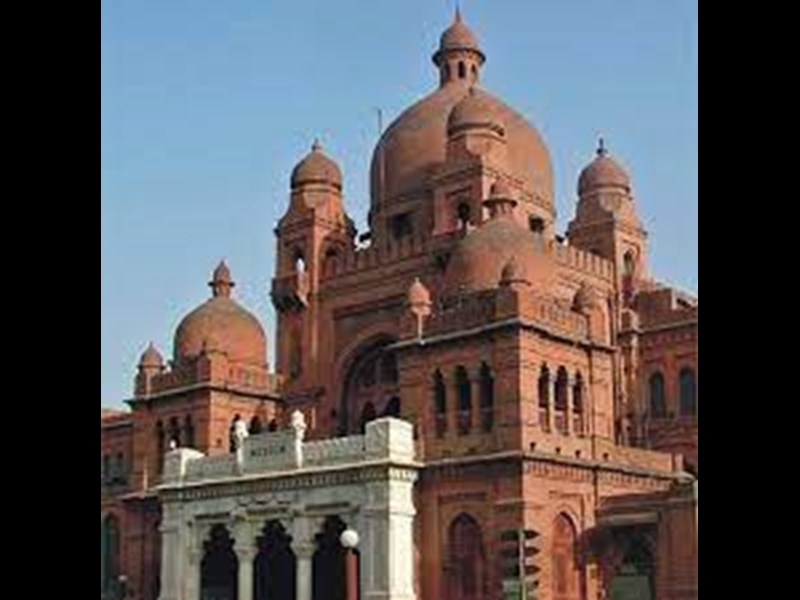The Lahore Museum

About - The Lahore Museum
In Lahore, Pakistan, there is a museum called the Lahore Museum. The Lahore Museum is the most popular and well-known institution in Pakistan and is still a significant South Asian museum. Additionally, there are musical instruments, historic jewellery, textiles, pottery, and weapons in the collection, along with some Tibetan and Nepalese artwork that is on display.
The Lahore Museum is Founded in 1865 at a smaller location and opened in 1894 at its current location on 'The Mall' in Lahore during the British colonial period.
Lahore Museum is Pakistan’s most visited and famous museums and remains one of the major museums in South Asia. Lahore Museum was originally established in 1865–66 on the site of the current Tollinton Market – a hall built for the 1864 Punjab Exhibition. The present building was constructed as a memorial of Golden Jubilee of Queen Victoria held in 1887, and financed through a special public fund raised on the occasion. The foundation stone of the new museum was laid on 3 February 1890 by Prince Albert Victor, Duke of Clarence and Queen Victoria's grandson. On its completion in 1894, the entire museum collection was transferred to present building with its new name as Jubilee Museum.
The museum has a number of Greco-Buddhist sculptures, Mughal and Pahari paintings on display. The collection contains important relics from the Indus Valley civilisation, Gandhara, and Graeco-Bactrian periods as well. The Fasting Buddha, dating from the Gandhara period, is one of the museums most prized and celebrated objects. The ceiling of the entrance hall features a large mural by renowned Pakistani artist Sadequain who originally made the mural in 1972 and 1973.The museum also contains fine specimens of Mughal and Sikh carved woodwork and has a large collection of paintings dating back to the British period. The collection also includes musical instruments, ancient jewellery, textiles, pottery, and armory, as well as some Tibetan and Nepalese work on display.
لاہور میوزیم
لاہور میوزیم، لاہور، پاکستان میں واقع ایک میوزیم ہے۔ 1865 میں ایک چھوٹی جگہ پر قائم کیا گیا تھااور برطانوی نوآبادیاتی دور میں لاہور میں 'دی مال' پر اپنے موجودہ مقام پر 1894 میں کھولا گیا۔
لاہور میوزیم پاکستان کا سب سے زیادہ دیکھا جانے والا اور مشہور میوزیم ہے اور یہ جنوبی ایشیا کے بڑے عجائب گھروں میں سے ایک ہے۔ لاہور میوزیم اصل میں موجودہ ٹولنٹن مارکیٹ کی جگہ پر 1865-66 میں قائم کیا گیا تھا - ایک ہال جو 1864 کی پنجاب نمائش کے لیے بنایا گیا تھا۔ موجودہ عمارت 1887 میں ملکہ وکٹوریہ کی گولڈن جوبلی کی یادگار کے طور پر تعمیر کی گئی تھی، اور اس موقع پر اکٹھے کیے گئے خصوصی عوامی فنڈ کے ذریعے مالی اعانت فراہم کی گئی تھی۔ نئے میوزیم کا سنگ بنیاد 3 فروری 1890 کو شہزادہ البرٹ وکٹر، ڈیوک آف کلیرنس اور ملکہ وکٹوریہ کے پوتے نے رکھا تھا۔ 1894 میں اس کی تکمیل پر، میوزیم کا پورا مجموعہ موجودہ عمارت کو اس کے نئے نام کے ساتھ جوبلی میوزیم میں منتقل کر دیا گیا۔
میوزیم میں متعدد گریکو بدھ مجسمے، مغل اور پہاڑی پینٹنگز نمائش کے لیے رکھی گئی ہیں۔ اس مجموعے میں وادی سندھ کی تہذیب، گندھارا اور گریکو-بیکٹرین ادوار کے اہم آثار بھی شامل ہیں۔ فاسٹنگ بدھا، جو گندھارا دور سے شروع ہوا، عجائب گھروں میں سب سے زیادہ قیمتی اور مشہور اشیاء میں سے ایک ہے۔ میوزیم میں مغل اور سکھوں کے نقش و نگار کے عمدہ نمونے بھی موجود ہیں اور اس میں برطانوی دور کی پینٹنگز کا ایک بڑا ذخیرہ موجود ہے۔ . اس مجموعے میں موسیقی کے آلات، قدیم زیورات، ٹیکسٹائل، مٹی کے برتن اور اسلحہ خانے کے ساتھ ساتھ نمائش کے لیے کچھ تبتی اور نیپالی کام بھی شامل ہیں۔
Location / Address
H895+93H, Mall Rd, Anarkali Bazaar Lahore, Punjab 54000